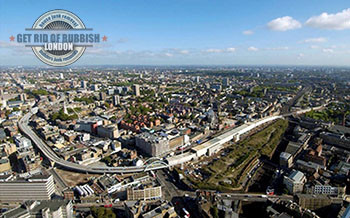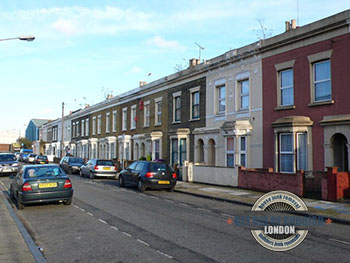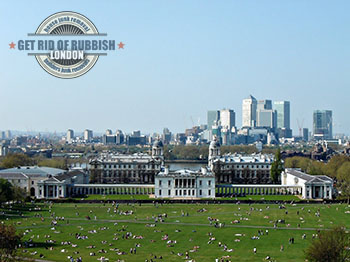East London is a part of the city that’s undergoing a natural change – it seems it’s being renovated by youthful energy and renewed by innovative development. The skyline and landscape of East London is also signalling change, and a positive one too. The modern day East side of London provides for what has become an iconic riverside living. The north bank of the Thames, from the historic area of Wapping to the skyscrapers of Canary Wharf (both in the borough of Tower Hamlets) are now prime area for real estate redevelopment and very popular with investors and those who (can fork out the cash and) wish to live there. The history of the East End is traditionally connected to maritime trade and seafaring, and many of the new building developments are based on converted dockland infrastructure like warehouses, wharves etc. The East End today is evidence that riverside living in London is still possible and once again regaining popularity, quite evident by the developments of historic Poplar, St Katherine Docks and Limehouse basin. One of the best places in the area, for water sports enthusiasts is Shadwell Basin Outdoor Activity Centre. The area was formerly run down as it suffered greatly during the Second World War and in the post war decades, but in the nineteen eighties, things began to change with the establishment of The Wapping Project – the brainchild of a group of young, enthusiastic artist who converted an old hydraulic power station. Although The Wapping Project is now closed, City Hall has planned a great redevelopment in the form of a new residential development featuring all the amenities.
 Administratively and geographically East London is divided into ten boroughs. By latest definitions they are Barking and Dagenham, Bexley, Greenwich, Hackney, Havering, Lewisham, Newham, Redbridge, Tower Hamlets and Waltham Forest. Although many of the areas in East London use the E postcode, this is by no means designative of the actual eastern portion of the city, and is purely used for postal administration purposes. Another people thing tend to confuse sometimes is East End with East London – East End is just a small portion of East London region, and occupies certain areas close to the ancient City of London, nearer the Thames riverbanks. Whereas, East London is a vast portion of the city, containing the ten boroughs listed above.
Administratively and geographically East London is divided into ten boroughs. By latest definitions they are Barking and Dagenham, Bexley, Greenwich, Hackney, Havering, Lewisham, Newham, Redbridge, Tower Hamlets and Waltham Forest. Although many of the areas in East London use the E postcode, this is by no means designative of the actual eastern portion of the city, and is purely used for postal administration purposes. Another people thing tend to confuse sometimes is East End with East London – East End is just a small portion of East London region, and occupies certain areas close to the ancient City of London, nearer the Thames riverbanks. Whereas, East London is a vast portion of the city, containing the ten boroughs listed above.
Originally, before the rapid urban expansion of the British capital, the East End was the traditional boundary of East London, it is considered by historians as the core of the Old East London. In modern times, there is a slight debate as to whether or not, modern East London can be overlapped with the traditional East End. Geographically, modern day East London is locked between: north of Thames, beyond the Roman period walls of City of London, all the way to the eastern section of the Metropolitan Greenbelt.
 Now for some of the boroughs of East London – Barking and Dagenham (the borough contains both urban centres of Barking and Dagenham) is one of the Outer London boroughs, situated about fourteen kilometres east of the City. The borough is one of the national priorities for urban regeneration. The borough has a population of about hundred and ninety thousand people, most of whom are living in the Becontree Estate. The borough was one of the six hosts of the 2012 London Summer Olympics. Hackney is another of the major boroughs of East London, though it is classified as part of Inner London. Some of the areas in Hackney are unofficially regarded as East London, and some North London respectively. Large portion of Hackney still retains its inner city look and feel, though lots has been done to improve and modernise the image of the borough in recent years. A number of gated communities have appeared throughout the borough. Havering is one of the larger Outer London boroughs, forming the boundary of East London. The borough is mainly suburban and features large green open spaces with under a protected status. Havering’s principal town – Romford is a major entertainment district, especially at night time. Romford and Havering are well developed in terms of economy, there are at least seven thousand businesses (industrial and commercial) in the borough.
Now for some of the boroughs of East London – Barking and Dagenham (the borough contains both urban centres of Barking and Dagenham) is one of the Outer London boroughs, situated about fourteen kilometres east of the City. The borough is one of the national priorities for urban regeneration. The borough has a population of about hundred and ninety thousand people, most of whom are living in the Becontree Estate. The borough was one of the six hosts of the 2012 London Summer Olympics. Hackney is another of the major boroughs of East London, though it is classified as part of Inner London. Some of the areas in Hackney are unofficially regarded as East London, and some North London respectively. Large portion of Hackney still retains its inner city look and feel, though lots has been done to improve and modernise the image of the borough in recent years. A number of gated communities have appeared throughout the borough. Havering is one of the larger Outer London boroughs, forming the boundary of East London. The borough is mainly suburban and features large green open spaces with under a protected status. Havering’s principal town – Romford is a major entertainment district, especially at night time. Romford and Havering are well developed in terms of economy, there are at least seven thousand businesses (industrial and commercial) in the borough.
 Newham is an East London borough which was formed by amalgamation of the former boroughs of West and East Ham. The modern day admin division is situated eight kilometres east of the City of London. Newham is the official home of the Olympics, containing the main venues for the games – Queen Elizabeth Olympic Park and the Olympic Stadium. The Borough of Redbridge in East London is one of the places to be in the city for exceptional parks, and award winning green open spaces. One of the leafiest suburbs around, Redbridge has not only got parks but also thriving shopping and commercial areas. Waltham Forest is one of the East London boroughs where contrasts are most evident. The north of the borough is mainly residential, with higher income households, the south of the borough is more industrial with lower income suburbs. The divide between the two halves of Waltham Forest also applies in terms of ethnicity of its residents. The Royal Borough of Greenwich is perhaps one of the best known ones worldwide, as it is also a key tourist attraction for its many sights and landmarks of international importance. The borough is home to many cultural and historic places of interest and is key to England’s former and to an extent current maritime history (commercial and wartime). As most people know, Greenwich is also the place where all universal time keeping across the world begins – the Zero Meridian or the Greenwich Meridian crosses the borough. The Royal Naval College and the famous Greenwich Observatory are all there too. Greenwich is also one of the five London Dockland Boroughs. The borough takes its name from the Anglo-Saxon word for green space (which it is really), though the district itself was named by Danish settlers.
Newham is an East London borough which was formed by amalgamation of the former boroughs of West and East Ham. The modern day admin division is situated eight kilometres east of the City of London. Newham is the official home of the Olympics, containing the main venues for the games – Queen Elizabeth Olympic Park and the Olympic Stadium. The Borough of Redbridge in East London is one of the places to be in the city for exceptional parks, and award winning green open spaces. One of the leafiest suburbs around, Redbridge has not only got parks but also thriving shopping and commercial areas. Waltham Forest is one of the East London boroughs where contrasts are most evident. The north of the borough is mainly residential, with higher income households, the south of the borough is more industrial with lower income suburbs. The divide between the two halves of Waltham Forest also applies in terms of ethnicity of its residents. The Royal Borough of Greenwich is perhaps one of the best known ones worldwide, as it is also a key tourist attraction for its many sights and landmarks of international importance. The borough is home to many cultural and historic places of interest and is key to England’s former and to an extent current maritime history (commercial and wartime). As most people know, Greenwich is also the place where all universal time keeping across the world begins – the Zero Meridian or the Greenwich Meridian crosses the borough. The Royal Naval College and the famous Greenwich Observatory are all there too. Greenwich is also one of the five London Dockland Boroughs. The borough takes its name from the Anglo-Saxon word for green space (which it is really), though the district itself was named by Danish settlers.
